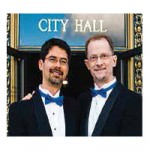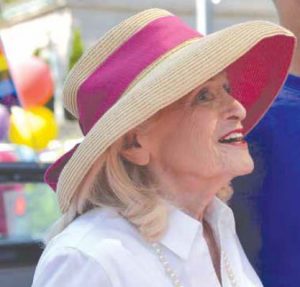 By Stuart Gaffney and John Lewis
By Stuart Gaffney and John Lewis
Although we met Edie Windsor only once, we’ll never forget the moment. It was on the steps of the United States Supreme Court back in March 2013, just minutes after the U.S. Supreme Court had concluded oral argument in Edie’s landmark lawsuit challenging the so-called Defense of Marriage Act (“DOMA”).
Edie had just finished a formal press conference, but she really wanted to be where her heart was: with all of the LGBTQ people gathered outside the Supreme Court that historic day. Edie was not to be denied—either before the Justices of the Court or with the LGBTQ community on the Court steps. As her legal team attempted to marshal her off the Supreme Court plaza, Edie, like the 84-year-old lesbian fireball of spirit, energy, and joy she was, stretched out her arms—really her entire body—to be part of all those gathered, including us.
When Time magazine honored Edie as Number 3 on its 2013 “Person of the Year” list, she responded: “The gay community is my ‘person of the year.’” She explained, “I am just one person who was part of the extraordinary and ongoing fight for marriage equality for all our families. There are thousands of people who helped us come this far and we still have a lot more work to do … . I look forward to continuing to fight for equal rights and educate the public about our lives alongside my gay brothers and sisters and our allies.”
 Edie was a long-time grassroots activist. She was an early active member of Marriage Equality New York, then Marriage Equality USA (MEUSA), the grassroots organization with which we worked for many years. Always feisty and outspoken, Edie recounted in the new anthology The People’s Victory how, when an LGBT leader at a community meeting urged patience in seeking marriage equality, she raised her hand and demanded: “I’m 77 years old and I can’t wait!! What do we have to do?”
Edie was a long-time grassroots activist. She was an early active member of Marriage Equality New York, then Marriage Equality USA (MEUSA), the grassroots organization with which we worked for many years. Always feisty and outspoken, Edie recounted in the new anthology The People’s Victory how, when an LGBT leader at a community meeting urged patience in seeking marriage equality, she raised her hand and demanded: “I’m 77 years old and I can’t wait!! What do we have to do?”
A key reason for urgency on Edie’s part was that her partner of over 40 years, Thea, was very ill with advanced multiple sclerosis. A tireless fighter, Edie went to every rally or event she could. At an organizing meeting, Edie met MEUSA leaders Michael Sabatino and Robert Voorheis, who made the connection that led to Edie marrying Thea in Canada.
Michael and Robert recount in The People’s Victory how Edie and Thea flew to Toronto, Canada, and were married by Canada’s first openly gay judge, Justice Harvey Brownstone, in May 2007. “Thea required assistance to get on and off the plane and to disassemble and reassemble her wheelchair. Edie recalled, ‘I couldn’t put a ring on her finger without someone holding her hand out because Thea was no longer able to lift her hand herself.'”
When Thea died, Edie had to pay over $363,000 in federal estate taxes because they were lesbians and the federal government would not recognize their marriage. Edie wanted to rectify this injustice through a federal lawsuit. When a number of LGBT leaders and organizations believed that her case was not the best one to challenge DOMA, Edie persisted and found private counsel to bring the case. Eventually, everyone—including the U.S. Justice Department itself—worked to achieve victory at the Supreme Court.
The Court found Edie’s story and the multitude of harms that DOMA inflicted on thousands and thousands of same-sex couples compelling, and declared DOMA unconstitutional. Justice Ginsburg later described Edie and Thea’s relationship as a “grand partnership.” At oral argument in Edie’s case, Justice Ginsburg opined that while heterosexual couples have “full marriage,” DOMA relegated same-sex couples like Edie and Thea to a second class, “skim milk marriage.”
The Supreme Court’s Windsor decision is powerful. In striking down DOMA, Justice Kennedy wrote: “DOMA instruct[ed] all federal officials, and indeed all persons with whom same-sex couples interact, including their own children, that their marriage [was] less worthy than the marriages of others.” DOMA’s purpose was to “injure” and “disparage” married same-sex couples and to make them “unequal” to everyone else. As such, DOMA violated the constitutional rights of LGBT couples.

Whenever we give presentations about marriage equality, we tell Edie and Thea’s story. On one memorable occasion, a middle school student, upon hearing how unfairly DOMA had treated Edie, yelled spontaneously in front of an entire school assembly, “That’s bulls–t!” Edie would have loved it.
Edie’s story is testament to the importance of standing up and speaking out over and over again. Her story is filled with love—and inspiration, and hope for LGBTQ people in the face of adversity. Edie embodies the power of our everyday personal stories and grassroots activism to change hearts and minds all across America all the way to the United States Supreme Court. Edie once described her experience after the Supreme Court victory to The New Yorker magazine as follows: “I don’t know how to say it that’s not corny as hell—I’ve been having a love affair with the gay community” and “I think Thea would love it.”
As we honor Edie at the time of her passing away, we are confident that the community—and America’s—love affair with Edie will live on for generations to come.
John Lewis and Stuart Gaffney, together for over three decades, were plaintiffs in the California case for equal marriage rights decided by the California Supreme Court in 2008. Their leadership in the nationwide grassroots organization Marriage Equality USA contributed in 2015 to making same-sex marriage legal nationwide.
Recent Comments